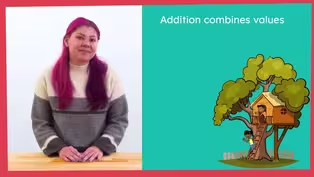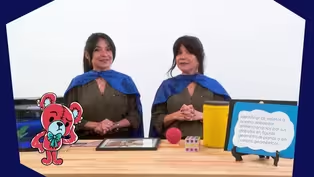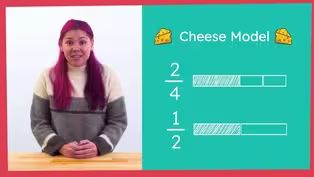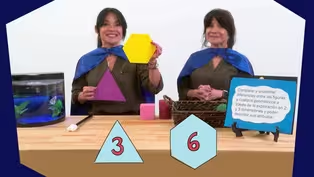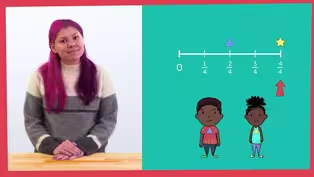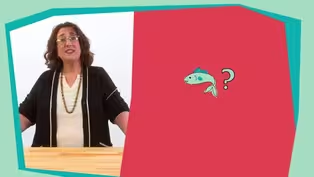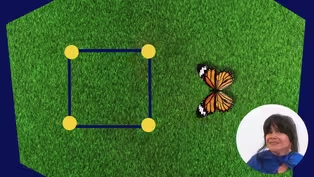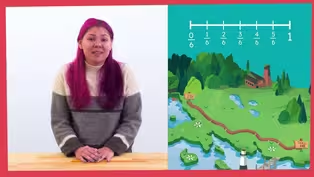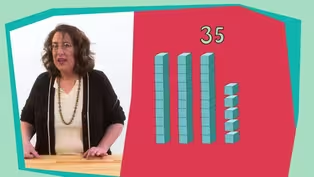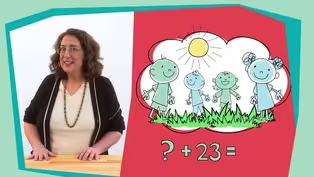
Episode 29 | Math Lessons
4/19/2021 | 28m 46sVideo has Closed Captions
Math lessons for early learners, led by NC teachers.
The first lesson (aimed at PreK-K learners) helps students understand the relationship between numbers and quantities. The second lesson (aimed at 1st-2nd graders) helps learners compare addition and subtraction strategies. Classroom Connection is your At-Home Learning companion where children love to learn. All lessons are led by NC educators.
Problems playing video? | Closed Captioning Feedback
Problems playing video? | Closed Captioning Feedback
At-Home Learning Presents: Classroom Connection is a local public television program presented by PBS NC

Episode 29 | Math Lessons
4/19/2021 | 28m 46sVideo has Closed Captions
The first lesson (aimed at PreK-K learners) helps students understand the relationship between numbers and quantities. The second lesson (aimed at 1st-2nd graders) helps learners compare addition and subtraction strategies. Classroom Connection is your At-Home Learning companion where children love to learn. All lessons are led by NC educators.
Problems playing video? | Closed Captioning Feedback
How to Watch At-Home Learning Presents: Classroom Connection
At-Home Learning Presents: Classroom Connection is available to stream on pbs.org and the free PBS App, available on iPhone, Apple TV, Android TV, Android smartphones, Amazon Fire TV, Amazon Fire Tablet, Roku, Samsung Smart TV, and Vizio.
Providing Support for PBS.org
Learn Moreabout PBS online sponsorshipMore from This Collection
Video has Closed Captions
Math lessons for early learners, led by NC teachers. (28m 46s)
Video has Closed Captions
Math lessons for early learners, led by NC teachers. (28m 46s)
Video has Closed Captions
Math lessons for early learners, led by NC teachers. (28m 46s)
Video has Closed Captions
Math lessons for early learners, led by NC teachers. (28m 46s)
Video has Closed Captions
Math lessons for early learners, led by NC teachers. (28m 46s)
Video has Closed Captions
Math lessons for early learners, led by NC teachers. (28m 46s)
Video has Closed Captions
Math lessons for early learners, led by NC teachers. (28m 46s)
Video has Closed Captions
Math lessons for early learners, led by NC teachers. (28m 46s)
Video has Closed Captions
Math lessons for early learners, led by NC teachers. (28m 45s)
Video has Closed Captions
Math lessons for early learners, led by NC teachers. (28m 46s)
Video has Closed Captions
Math lessons for early learners, led by NC teachers. (28m 45s)
Video has Closed Captions
Math lessons for early learners, led by NC teachers. (28m 46s)
Providing Support for PBS.org
Learn Moreabout PBS online sponsorship[cheerful upbeat music] ♪ - Okay, okay, okay, okay, okay, okay.
Guess what?
A jiffy is an actual unit of time.
It means 1/100 of a second.
That's like faster than I can snap.
Okay, well, here's today's math lesson.
It's coming to you in three or four jiffies.
Did you catch that?
- Hello, super learners.
Ms. M here.
I'm so glad that you are here today.
Are you ready for another math adventure?
Well, let's get started with the song.
♪ Hello, super learners, how are you ♪ ♪ Hello, super learners, how are you ♪ ♪ I'm so glad you're here today ♪ ♪ And I hope you feel the same ♪ ♪ Hello, super learners, how are you ♪ I feel wonderful today, super learners, and I really hope you do too.
Now it's time for our math power warmups counting to 20.
Are you ready?
Because here we go.
[air whooshes] ♪ 1, 2, 3, 4, 5, 6, 7 ♪ ♪ 8, 9, 10, 11, 12 ♪ ♪ 13, 14, 15, 16, 17, 18 ♪ ♪ 19, 20, that was fun.
♪ Now let's count to 20 in another way.
Are you ready to snap count with me?
Let's snap count all the way to 20.
Let's go.
1, 2, 3.
[snaps] 4, 5, 6.
7, 8, 9, 10, let's keep going.
11, 12, 13, 14, 15, 16, 17, 18, 19, 20, yes.
Super learners are the best.
I'm getting warmed up.
Are you?
Excellent.
One more time counting to 20, but this time let's do it in Spanish.
[speaks Spanish] 20!
Excellent.
Now it's time to review our colors.
Let's say them in English and Spanish.
[speaks Spanish] red, [speaks Spanish] orange, [speaks Spanish] yellow, [speaks Spanish] green, [speaks Spanish] blue, [speaks Spanish] purple, [speaks Spanish] brown, [speaks Spanish] black, [speaks Spanish] white, And [speaks Spanish], gray.
Look for these colors in the world today.
And now for our last math power warm up, the shape game.
You will see a shape, and then you say its name in English or Spanish.
[speaks Spanish] square, [speaks Spanish] circle, [speaks Spanish] triangle, [speaks Spanish] rectangle, [speaks Spanish] rhombus, [speaks Spanish] trapezoid, [speaks Spanish], hexagon, [speaks Spanish], cube, [speaks Spanish], cone, [speaks Spanish], cylinder, [speaks Spanish] sphere.
Math-tastic.
[air whooshes] We have finished all of our math warmups.
So now it's time for [taps] our math mission of the day!
Come on, let's check with Sparkles the fish to see what our mission is today.
Thank you, Sparkles.
All right, let's read.
Dear super learners, your mission today is to use the super amazing math power of subitizing to recognize the amount of objects.
Super learners, subitizing is the super math power where you know the number of objects without even counting.
You can tell just by looking!
So today we will use our mighty math minds to subitize.
Super learners, I know we can do this mission.
♪ Dah dah dah dah ♪ Doo doo doo doo.
Oh, make sure it goes on the right way.
Cape's on.
Math power up.
Let's go.
[air whooshes] Let's practice the super math power first on our hands.
[lighthearted music] I'm going to hold up different amounts of fingers on my hand.
See if you know the amount of fingers I have up right away.
I know you can do this.
Ready?
Math power up.
How many?
Yes.
One.
How many?
Yes.
Two.
How many?
Yes.
Three.
How many?
Yes.
Four.
How many?
Yes.
Five.
Great, now I will hold up different amounts of fingers, but not in order.
So remember to pay attention.
How many?
Yes.
Two.
How many?
Yes.
Five.
How many?
Yes.
Three.
How many?
Yes.
One.
How many?
Yes.
Four.
How many?
Oh, that was a little bit tricky, but yes, zero.
Great job, super learners.
We just subitized.
Now pay attention to the screen.
Different amounts of dots are going to appear.
Subitize and say the amount or number.
Ready?
Math power up.
How many?
Yes.
Three.
How many?
You got it.
Two.
How many?
Yep.
Four.
How many?
Yes.
One.
How many?
Yes.
Five.
Let's look at the five dots a different way.
Yep.
Still five.
So no matter how the five dots are arranged, we can always subitize that there are five dots.
Amazing, super learners.
You are really great at this.
Let's take a math movement break, then we can continue it.
Let's act out a math story.
The story will tell us when to move.
Ready?
Here we go.
Once there was a little duck.
The duck wanted to go for a swim.
The duck warmed up for swimming by doing five stretches.
Okay, super learners, let's stretch five times.
One, two, three, four, five.
Next the duck to one big jump in the water.
Let's jump.
One, then the duck kicked his little feet four times.
Let's kick safely.
Four kicks.
One, two, three, four.
Then the duck flapped its wings eight times.
Let's flap.
1, 2, 3, 4, 5, 6, 7, 8.
Finally, the duck started swimming.
The duck swam 10 laps.
Let's swim, super learners.
1, 2, 3, 4, 5, 6, 7, 8, 9, 10.
The duck was so happy, it did three spins.
One, two, three.
Let's spin.
One, two, and three.
Then it went home waddling all the way.
Waddle, waddle, waddle, waddle.
That was so much fun.
Ready to subitize some more?
All right, let's go.
Look, there are some pompoms in this group all together very nicely.
Look at this group.
How many pompoms do you see?
Yes.
There's five.
Let's look again.
Oh, I need to take the ducky outside.
I'll be right back.
Come on ducky.
[mischievous music] [lighthearted music] Hey, what happened?
Uh oh, looks like the math burglar has a challenge for us.
There are now two smaller groups of objects, but how many are there altogether?
We can super subitize by combining the groups and knowing the number without counting them.
Again.
We can do it.
See, if we look at this group, we know there are three.
And now if we look at this group, we know there are two.
Now, if we look at them together, how many are in total?
Five.
Yes, there are five.
We solved the math burglar's puzzle!
That was fun.
Let's play again.
I will make two smaller groups, but tell me the total of the two groups.
Not the individual group amounts.
All right?
How many in total?
Yes, three.
Two and one are three.
One more time, super learners.
Here are two more mini groups.
How many in total?
Yes, there are four.
Two and two are four.
Amazing, super learners.
Or should I say super subitizers.
Wow, we have subitized a lot.
Let's check back with Sparkles the fish.
Mission complete.
Hooray.
Congratulations, super learners.
You used your math powers and completed the mission.
Was is it time to do?
Let's review.
Today, we used our math power and subitized sets of objects.
We can look at sets of objects and know the amount without counting them.
Practice subitizing today, super learners.
You can share your math power by showing it to someone.
Thank you, super learners, for going on a math mission with me today.
Sparkles thanks to you too.
Remember, you have the power to be super at math.
Bye, adios.
Math power out!
[bright music] - Books are the best.
[laid back music] I can still remember one of my favorites from when I was your age.
What's your favorite book?
Oh, now that's a good one.
I love reading, and I love listening to other people read.
Check out this video, one of my favorite books.
- Hi, my name's Milton, and I'm going to read "Mr. Cookie Baker."
[wondrous music] Early in the morning, Mr. Baker gets ready to make cookies.
He counts and measures the ingredients for his recipe.
He mixes his cookie dough.
Then he rolls out the dough and cuts out shapes with cookie cutters.
The cookies bake in the oven.
Out they come, nicely browned.
What a delicious smell.
Mr. Baker decorates the cookies with icing and colored sprinkles.
Now he is ready for customers.
Here come the hungry children.
[children cheer] Mr. Baker shows off his cookies.
He is proud.
Mrs. Baker sells the cookies.
The shop is crowded.
The cookies are sold.
It is time to close.
At last, a cookie for Mr. Baker.
Good night.
- Today's affirmation is love is all around me.
[lighthearted music] Are you ready?
Love is all around me.
Love is all around me.
Love is all around me.
- Did you know the average yawn lasts six seconds?
1, 2, 3, 4, 5, 6.
Next time you yawn, count and see how long it lasts.
But you won't be yawning anytime soon, because we have a super cool math lesson for you.
This will help count down those seconds.
- Hi friends, Splat and I are back with you today for our last number talk.
My name is Dawn, and we are so happy to be here.
Remember, number talks help us practice solving math problems in our head, and they help us explain our thinking.
Today, we are going to practice solving subtraction problems in our head by decomposing or breaking apart numbers before we take them away from the minuend.
Remember that subtraction means that we are taking something away, and the minuend is the number we are beginning with in the subtraction problem.
[gentle electronic music] We are going to use a chart like this to organize our thinking.
We will add math problems to each box and show our thinking on how we solved these problems.
Before we get started, you might want to grab some items to help you with explaining your thinking and learning today.
You might want to get a stuffed animal or a trusted adult to talk to so you can explain your thinking, and you can always tell Splat.
You also might want to get some paper and pencil or a notebook to write down your learnings at the end of our time together.
This could be your math journal.
We'll wait while you go get anything you need for today.
[cheerful music] Welcome back, I hope you were able to find everything you need.
Subtraction.
We hear that word a lot, but do we think about what it means?
Let's use a Frayer model to think about it some more.
Let's take a piece of paper and fold it in half hamburger style, and then fold it in half again to make four equally sized rectangles.
Then in the corner of our paper, where all sides are folded, we'll fold down a small triangle.
When you unfold your paper, the fold should look like this.
Does yours look like mine?
Okay, great.
We're going to write subtraction in the center diamond because this is the word we need to understand more about.
Then in the upper left rectangle, we're going to define this word, or write what subtraction means.
So let's write the word definition here.
Okay, great.
In the upper right rectangle, we're going to provide an example of subtraction.
So let's write example here.
[pencil scrapes] Then in the lower left rectangle, we'll provide a non-example, or what subtraction is not, so write non-example here.
[pencil scrapes] And finally, in the lower right rectangle, we'll draw a picture to help us visualize what subtraction is.
So let's write picture here to remind us of what we're supposed to do.
So now let's think about what subtraction means.
So Splat and I are in the North Carolina mountains picking apples, and he took away the apples he picked, that would be subtraction.
So then we could say subtraction is when we take away from a group or a number of things.
Splat and I are going to give you some time to write this definition in your Frayer model.
[dynamic music] As we learn more about subtraction in today's lesson, you will be able to add examples, non-examples, and draw a picture to share your growing understanding of subtraction.
Let's get started.
Here's our first expression.
23 minus 3.
I want you to think in your head how you would solve this by taking 3 away from the minuend, which is 23.
[upbeat music] Will you tell an adult or stuffed animal your answer?
I bet you told an adult or stuffed animal that the answer is 20.
That's correct.
Will you explain your thinking to me about how you solved this in your head?
I heard someone say that they knew that 23 was two 10s and three 1s.
Then they subtracted or took away the three 1s, and that left them with two 10s, which is also known as 20.
That is really awesome thinking.
I think we're ready for our next one.
And here it is, 23 minus 5.
Will you solve this problem in your head?
Now tell an adult or stuffed animal what you think the answer is.
And Splat will whisper it to me.
[Splat beeps] Splat whispered to me that he thinks the answer is 18.
Is that what you said?
Oh, that is great thinking.
Now, can you tell an adult or stuffed animal how you know the answer is 18?
I heard someone say that they know that 2 plus 3 equals 5, so they knew they could subtract 3 from 23 and get 20.
Then they still had 2 left to subtract.
So they subtracted 2 from 20, and they got 18.
That is awesome thinking about decomposing the 5 into 2 and 3, and then subtracting.
[calm music] You're really getting the hang of this.
Let's try another one.
25 take away 5.
Think in your head about what the answer is.
Now, will you tell Splat what you think the answer is?
Yes, 20.
That's correct.
Will you explain your thinking on how you got the answer of 20?
I heard someone say that this was like our first problem.
Yes, it is.
So they knew that 25 was made up of 20 plus five 1s.
They took away or so attracted the five 1s and were left with 20, which has the same value as two 10s.
Great way to use the equation we already worked hard to solve.
All right, friends, Splat and I have a problem for you to solve together.
Here it is.
25 take away 7.
Will you think about this expression and how you would solve it?
Will you tell Squat and me what your answer is?
18.
Yes, that's correct.
[Splat beeps] Great job solving that expression.
Will you now explain your thinking to Splat and me?
What great thinking about how to find the answer to this problem.
I'm going to explain our thinking and show it on a number line.
We are going to begin with the number 25.
Can you think about why we would begin with the number 25?
Did you think about that we are starting with 25 and subtracting 7?
That's right.
Splat and I know that 7 can be decomposed into 5 and 2.
So we will subtract 5 from 25, like in the last problem.
And then we will get to 20 on our number line.
Then we know we have two more left us attract.
So we will count back by 1s from 20.
First we land on 19 and then we land on 18.
That was a great job using the number line.
[air whooshes] Friends, it has been so fun doing mental math and number talks with you.
You worked hard to decompose numbers to help you subtract a little easier and in your head.
We also showed our thinking by using an open number line.
Splat and I have had such a great time learning all about numbers with you and how they can work together to help you solve problems.
Before we go, Splat and I would love to hear what you have learned in your own words.
I have these sentence starters, and I'm hoping you can finish these sentences with me.
They say, "Today in math, I learned," and, "I can."
So if I were doing this, I might say, "Today in math, I learned how to subtract numbers using mental math.
I can decompose a number into smaller numbers to help me subtract to find the difference."
Now it's your turn.
Read this with me and finish it by telling an adult or stuffed animal.
Today in math, I learned.
Now let's read our next sentence starter, and you can finish it.
I can.
That was really great thinking and talking about everything you learned today.
Now that you've said your sentences out loud, you can write them on your paper or in your notebook to create a math journal of your learning.
Splat and I want to help you finish your Frayer model about subtraction.
Let's add to the rectangle that says example.
An example of subtraction could be 16 take away 8, because that would show taking away 8 from 16.
We'll give you time to add that to your chart.
Now let's think about a non-example, or what subtraction is not.
You could write 10 plus 10 as a non-example since this would be adding two groups of things together.
We'll give you some time to add this to your chart.
[cheerful music] Now that we've done this together, Splat and I challenge you to add a picture of subtraction to your chart in the rectangle that says picture.
We also challenge you to add more examples and non-examples to your chart.
All of this will help show your understanding of subtraction.
And then you can explain your Frayer model to an adult or stuffed animal out loud.
Splat and I must go now.
[cat meows] We have loved hearing you explain your thinking about how you solved those problems and hearing what you learned in your own words.
That took some really hard thinking, and you all did great.
- Knock, knock.
- [Woman] Who's there?
- Gorilla.
[drum rolls] - [Woman] Gorilla who?
- Gorilla me a hotdog, will you?
[cymbals clash] [laid back music] - Ah shoot.
That's all the time we have for today, y'all.
But I'll see you right back here in no time.
Let's see those thumbs up.
Dope.
I'll see you soon.
Peace, love, and learn, super learners.
All right.
[cheerful upbeat music] ♪
Support for PBS provided by:
At-Home Learning Presents: Classroom Connection is a local public television program presented by PBS NC
